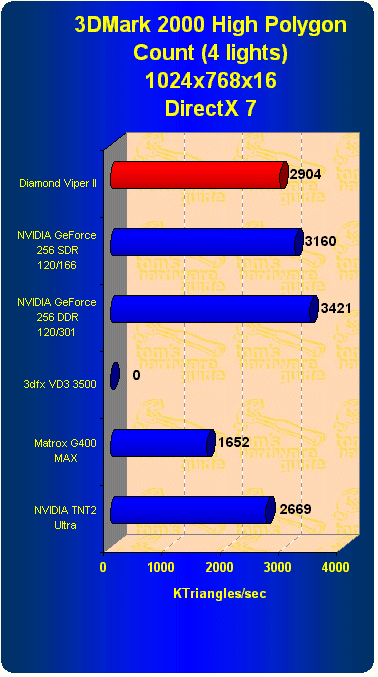S3 Diamond Viper II Review
3D Mark 2000 High Polygon Count

The results in this test are showing me something that I hoped wouldn't happen. The video cards without T&L must rely on the speed of the CPU (which uses KNI in DirectX 7) to calculate all the T&L information. The CPU should do well but match the performance of the GeForce GPU that has built in T&L. As you can see from the results, the boards without T&L come very close to the GeForce cards. I will be investigating this further but from what I've found out so far, the 3DMark benchmark doesn't use DirectX 7 only but has a mix of custom code involved. This also makes us realize that it's very possible that game developers may do something similar to support a wide array of cards which would hurt the performance of the GeForce cards.

Here we have more data to support what I mentioned above. Notice that only the GeForce cards took a penalty when switching to 32 bit color mode. The video cards relying on the CPU for T&L can split the workload between the graphics card and CPU (so you'll see little to no performance drop) while the GeForce cards take a slight hit in performance because they're having to deal with the 32 bit color stealing a heavy amount of bandwidth.
Overall my feelings about the actual Viper II performance are mixed. I think the Viper has showed us great performance potential in multi-texturing situations. The drivers are going to play a huge part in this as well. We can see that the drivers were tuned very well for Quake 3 but the poor performance in OpenGL Descent 3 has proven to us that this OpenGL ICD driver still needs some tuning. You can also see that without the comfort of multi-texturing being used, the Viper II has a difficult time keeping up with the more flexible GeForce cards.
Stay on the Cutting Edge
Join the experts who read Tom's Hardware for the inside track on enthusiast PC tech news — and have for over 25 years. We'll send breaking news and in-depth reviews of CPUs, GPUs, AI, maker hardware and more straight to your inbox.
Current page: 3D Mark 2000 High Polygon Count
Prev Page 3D Mark 2000 Fill Rate (quad Texture) Next Page ConclusionMost Popular

